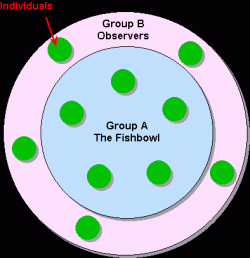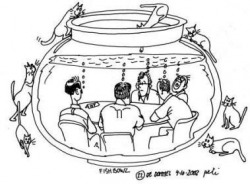Fishbowls
What is it?
The fishbowl is a discussion format that allows all individuals involved to participate. It is especially useful for larger groups. This type of discussion allows everyone to contribute and to observe. There are two types of fishbowl, the open fishbowl and the closed fishbowl.
How do you use it?
The fishbowl has a small group of chairs in an inner circle and one or multiple circles of chairs surrounding the inner circle. The inner chairs are occupied by the contributors and the outer chairs are occupied by the observers. There is a moderator (usually the instructor/facilitator) who introduces the topic for discussion and begins and ends the session. When the session has concluded, the moderator will recap the discussion.
The Open Fishbowl:
In the open fishbowl, one seat in the inner circle is left vacant. At any time during the discussion, an observer can enter the inner circle and in turn, one of the contributors must voluntarily leave the inner circle. Participants will frequently enter and exit the inner circle until the discussion concludes.
The Closed Fishbowl:
In the closed fishbowl, all seats in the inner circle are occupied. When time runs out, the contributors vacate the inner circle and observers fill those seats. This continues until everyone has had their opportunity in the inner circle.
Variations:
The Feedback Fishbowl:
The inner circle discusses a topic for short period of time. When the time is up, the inner circle turns around in their chairs to face the observers who give them feedback. The inner circle turn back around again and the feedback. When the time is up, the participants from the inner and outer circle switch places and repeat the procedure.
The Homogeneous Fishbowl:
The fishbowl is comprised of individuals who share the same opinion. The idea is to gain new perspectives and understanding of the subject.
The Heterogeneous Fishbowl:
If there is more than one side to a topic of discussion, one person from each perspective sits in the inner circle.
Multiple Fishbowls:
For large groups, more than one fishbowl can take place at the same time. When time has run out, one or two members from each fishbowl will form a new fishbowl. The views from each group will be discussed. When this discussion is completed, everyone returns to their original fishbowl for further discussion.
The Open Fishbowl:
In the open fishbowl, one seat in the inner circle is left vacant. At any time during the discussion, an observer can enter the inner circle and in turn, one of the contributors must voluntarily leave the inner circle. Participants will frequently enter and exit the inner circle until the discussion concludes.
The Closed Fishbowl:
In the closed fishbowl, all seats in the inner circle are occupied. When time runs out, the contributors vacate the inner circle and observers fill those seats. This continues until everyone has had their opportunity in the inner circle.
Variations:
The Feedback Fishbowl:
The inner circle discusses a topic for short period of time. When the time is up, the inner circle turns around in their chairs to face the observers who give them feedback. The inner circle turn back around again and the feedback. When the time is up, the participants from the inner and outer circle switch places and repeat the procedure.
The Homogeneous Fishbowl:
The fishbowl is comprised of individuals who share the same opinion. The idea is to gain new perspectives and understanding of the subject.
The Heterogeneous Fishbowl:
If there is more than one side to a topic of discussion, one person from each perspective sits in the inner circle.
Multiple Fishbowls:
For large groups, more than one fishbowl can take place at the same time. When time has run out, one or two members from each fishbowl will form a new fishbowl. The views from each group will be discussed. When this discussion is completed, everyone returns to their original fishbowl for further discussion.
Why use it?
- The fishbowl is a great way to promote participation from all the individuals involved in the discussion.
- Fishbowls are an excellent way to discuss controversial topics.
- The fishbowl is a good alternative to the traditional debate.
Advantages:
- Everyone has an equal opportunity to participate
- Each participant can have their say without being interrupted
- The contributors can freely state their opinion on the subject
- It enables the student to become a better listener
Disadvantages:
- Observers could get edgy just sitting and listening
- Too much of an urge for observers to interrupt
- Some participants may feel awkward about opening up, speaking their mind
- Some participants might worry about repercussions from their comments
Examples
This is an example of how a fishbowl can be conducted.
Another example of a fishbowl would be to have students or participants enter into a discussion of religion and how it has affected the culture they currently live in. Ask participants to speak regarding their own personal background and comment on why they do or don't buy into the practice. This is a controversial subject that has possibilities to open up better understanding amongst students in a very multicultural class. The students observing can record and than give feedback to the participants regarding their facial expressions and body language and comment on the similarities in the arguments that are brought forth. The feedback session gives the non-fishbowl participants a chance to participate. The roles should then be reversed. Debriefing afterward should be done by the instructor to discuss if the second group had different tactics after being observers first and were their results similar. Discussion of the students level of comfort with the activity is good feedback for the instructor. This activity allows students to examine their preconceptions of other cultures. It would be useful in many different areas of study where participants will deal with the public.
Videotaping a fishbowl activity and playing it back to the participants allows participants to view themselves interacting within the group and can provide great incite for personal reflection. it is also a great tool for evaluating the success or failure of the activity .
Videotaping a fishbowl activity and playing it back to the participants allows participants to view themselves interacting within the group and can provide great incite for personal reflection. it is also a great tool for evaluating the success or failure of the activity .
References
Epstein,Peggy. (n.d.). How to create a fishbowl observation lesson. Retrieved June 10, 2010, from http://www.ehow.com/how_4516715_create-fishbowl-observation-lesson.html
Pappas, Peter. (n.d.). Strategies that Work, Fishbowl Discussion. Retrieved June 01,2010. from http://peterpappas.blogs.com/files/fishbowl-discussion-.pdf
Sterling, Shirley., Tohe, Laura.(2010). Workshop 3: Research and Discovery, Teaching Strategies, Fishbowl. Retrieved June 04,2010, from http://www.learner.org/workshops/tml/workshop3/teaching2.html
Wambeke, Tom. (2009). Facilitate a Fishbowl Discussion. Retrieved May 30,2010. from http://itcilo.wordpress.com/2009/02/16/facilitate-a-fishbowl-discussion/
Fishbowl (conversation). (2010). Retrieved June 04,2010. from http://en.wikipedia.org/wiki/Fishbowl_(conversation)
Pappas, Peter. (n.d.). Strategies that Work, Fishbowl Discussion. Retrieved June 01,2010. from http://peterpappas.blogs.com/files/fishbowl-discussion-.pdf
Sterling, Shirley., Tohe, Laura.(2010). Workshop 3: Research and Discovery, Teaching Strategies, Fishbowl. Retrieved June 04,2010, from http://www.learner.org/workshops/tml/workshop3/teaching2.html
Wambeke, Tom. (2009). Facilitate a Fishbowl Discussion. Retrieved May 30,2010. from http://itcilo.wordpress.com/2009/02/16/facilitate-a-fishbowl-discussion/
Fishbowl (conversation). (2010). Retrieved June 04,2010. from http://en.wikipedia.org/wiki/Fishbowl_(conversation)


